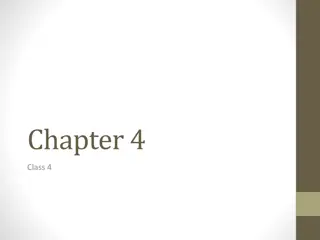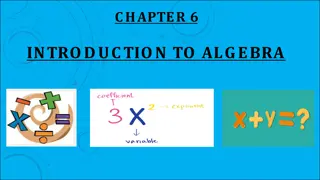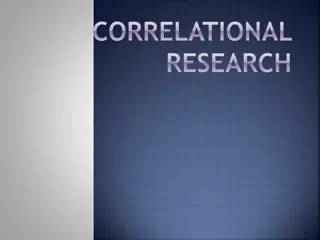Understanding Correlation in Financial Algebra
Explore the concept of correlation in financial algebra through examples showcasing positive and negative correlations between variables. Learn how to interpret scatter plots and understand the impact of lurking variables on perceived relationships between data points.
Download Presentation

Please find below an Image/Link to download the presentation.
The content on the website is provided AS IS for your information and personal use only. It may not be sold, licensed, or shared on other websites without obtaining consent from the author. Download presentation by click this link. If you encounter any issues during the download, it is possible that the publisher has removed the file from their server.
E N D
Presentation Transcript
1-5 Personal Expenses Advanced Financial Algebra
Introduction Past trends can help predict future occurences. Sketch a scatter plot of data means to put separate data points on a graph and do not connect them. Trend = relationship between two variables (letters/unknowns) Positive correlation = one variable increases as the other variable increases Negative correlation = one variable decreases as the other variable increases
Example 1 - table for scatter plot Ravi is 16 and has a part time job. He is trying to relate monthly income and monthly clothing purchases for some of his classmates. Draw a scatter plot of the data to help. SOLUTION: Remember to scale and label your axes properly. Sketch this graph in your notes.
Example 1 continued Is there a correlation in the data points sketched in the scatter plot on the previous slide? SOLUTION: Answer: Yes, there is a positive correlation. Work: As a income increases, so does clothing spending.
Example 2 - more on correlation Jamil buys contact lenses 6 to a box. He is wondering if there is a correlation between the number of boxes purchased at one time and the price per lens graphed below(sketch in notes)?
Example 2 - SOLUTION Answer: Yes, there is a negative correlation. Work: As the number of boxes purchased increased (to the right), the price decreased. Notice the fact that it looks like it is sloping (trending) down to the right (negative slope). X is the independent variable = # of boxes purchased Y is the dependent variable = $ price
Example 3 - lurking variables Tiana looked at the teen spending chart below showing shoe spending and personal care spending. The graph has a positive correlation. Does that mean spending more on shoes causes you to spend more on personal care?
Example 3 - SOLUTION Notice the variables of age and income are not mentioned in the problem statement and cannot be classified as explanatory or response variables. In this case, age and income would be called lurking variables. A lurking variable is an external variable that may influence how variables are perceived to be related to one another. Because of the unseen lurking variable, people tend to make causality assumptions between variables where they do not exist. Keep in mind that if two variables are correlated, they are associated in some way but one does not necessarily have to cause the other. The amount spent on cosmetics does not cause the amount spent on shoes to be a certain value. There are other factors involved.
Example 4 The graph (scatter plot) at the right shows coffee purchases during a semester and GPA. a) Describe any patterns you see in the data. b) Is there any correlation? SOLUTION: Answer: No patterns and no correlation Work: The points are really all over the place. They do not show a positive or negative slope trend
Example 5 - Linear Regression Analysis steps 1. Draw a line of best fit through the middle of the points with some points above and some points below spread as evenly as possible. 2. Write an equation through two representative points y = mx + b 3. Use that equation to make future predictions.
Example 5 - SOLUTION Step 1 draw line of best fit (339, 75) (296, 63)
Example 5 - SOLUTION Step 2 write equation GOAL: y = mx + b Pick two representative points and calculate slope (see arrows on previous slide). m = slope = ???? ?2 ?1= (0, b) = y-intercept y = mx + b ???= ?2 ?1 75 63 339 296= 12 43= m .279 Substitute either point for x and y: Solve for b: Subtract: Isolate b: Write equation: 63 = .279 (296) + b 63 = 82.6 + b -82.6 -82.6 b = -19.6 y = .279x 19.6
Example 5 - SOLUTION Step 3 make prediction What if one of Ravi s classmates had a monthly income of $500? How much would our equation tell us that we could expect them to spend approximately? Round to the nearest dollar. SOLUTION: y = .279x 19.6 y = .279($500) 19.6 119.9 They will likely spend about $120 per month on clothing.
Example 6 - slope What does the slope from example #5 mean? SOLUTION: Slope = m .279 = ???? ???= ? ???? ?? ???? ??? ???????? ? ???? ?? ?????? When income goes up $1, the clothing spending goes up about $.28 = 28 .28
Assignment: pg 51 #3, 4, 7-11 all continued 4. The MyTunes song app sells music downloads. Over the past few years, the service has lowered its prices. The table below shows the price per song and the number of songs downloaded per day at that price. a) Examine the data without drawing a scatter plot. Describe any trends you see. b) Draw a scatter plot. Describe the correlation. c) Approximate the number of downloads at a price of $.54 per song. Explain your reasoning.
Assignment: pg 51 #3, 4, 7-11 all continued 9. 10. a) Is it possible for a linear regression line to go through every point on a scatter plot? b) Is it possible for a linear regression line to not go through any point on a scatter plot? c) Explain your answer to a) and b)
Assignment: pg 51 #3, 4, 8-11a-d continued 11. Use these data from Example #2 in the notes about the number of boxes purchased and the price per contact lens to answer the questions below. (1, 6.00), (2, 5.90), (4, 5.40), (8, 5.20), (10, 4.80), (12, 4.10), (14, 3.80), (16, 3.10), (20, 2.50), (24, 1.70) a) Find the linear regression equation. Round the slope and the y-intercept to the nearest hundredth. b) What is the slope of the linear regression line? c) What are the units of the slope when it is expressed as a rate? d) Based on the linear regression equation, what would be the price per lens if he bought 22 boxes?






















